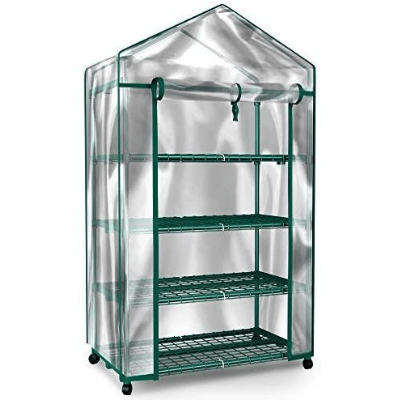
Home-Complete Mini Greenhouse-4-Tier Indoor Greenhouse
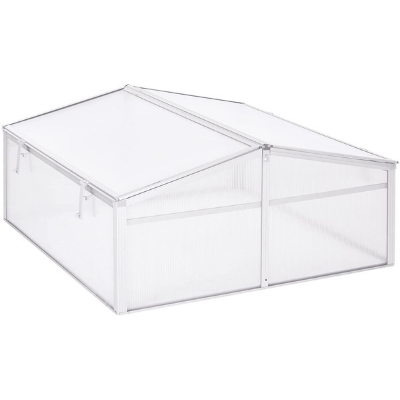
Outsunny 39" Aluminum Vented Cold Frame Mini Greenhouse Kit
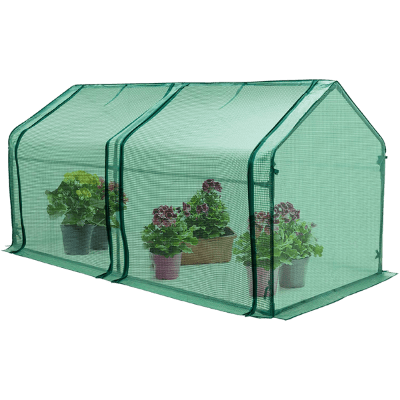
EAGLE PEAK Mini Garden Portable Indoor Greenhouse
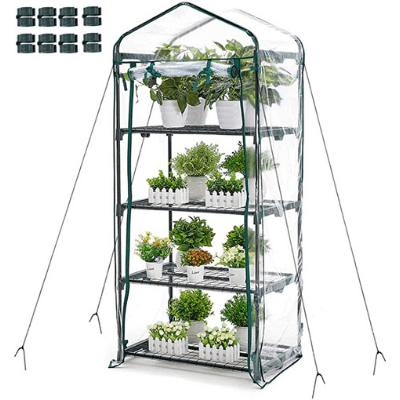
AMERLIFE Greenhouse 4 Tier Indoor Greenhouse
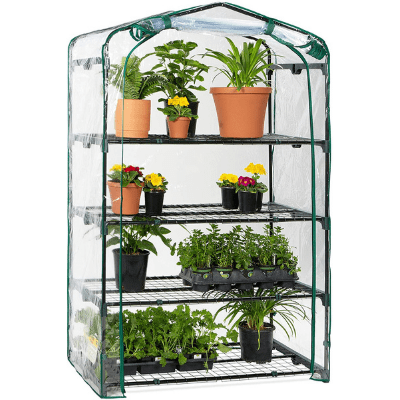
Best Choice Products 40in Wide 4-Tier Mini Greenhouse
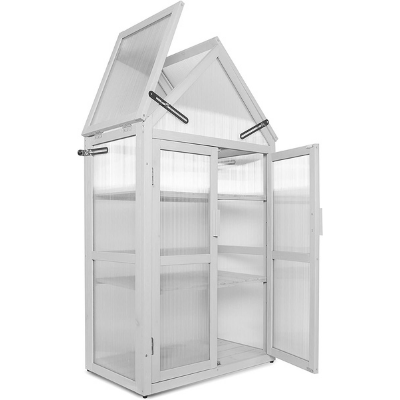
Kitchen Joy Indoor Greenhouse
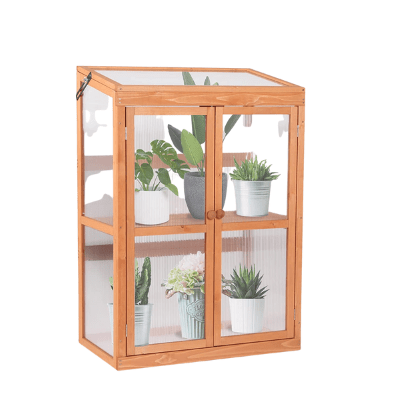
Mcombo Greenhouse Wooden Cold Frame Greenhouse
Growing sustainable food at home has never been easier. Even if you live in an apartment, an indoor greenhouse can keep you supplied with fresh vegetables, herbs, and even fruits all year round.
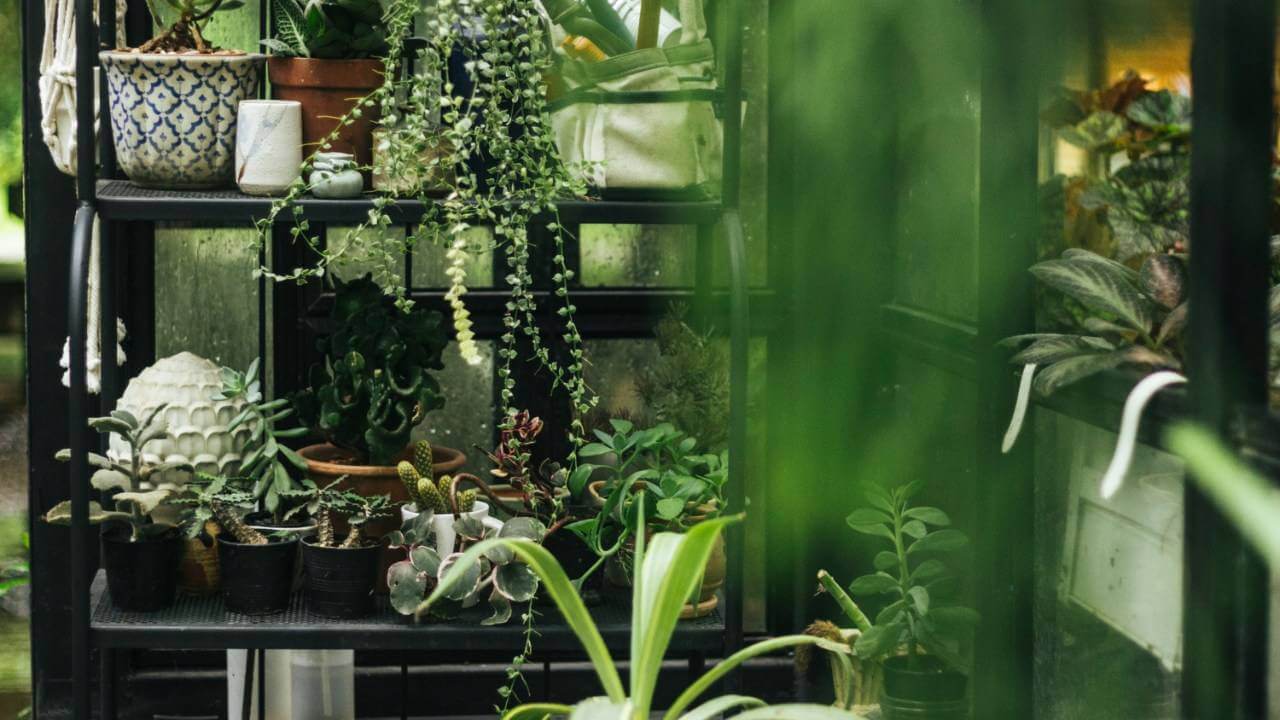
I still remember the day I brought home my first indoor greenhouse—a modest, clear plastic enclosure, no bigger than a nightstand. It was a simple step that sprouted into a full-blown passion for indoor gardening, transforming my living space into a lush, green sanctuary.
It's not just me; this verdant trend is taking root globally. In fact, the indoor gardening market has seen a growth spurt, with projections showing an increase of 5.7% from 2020 to 2027. This surge reflects a growing awareness of the benefits of having nature close by—especially when outdoor space is at a premium.
As we delve into the world of indoor greenhouses, I'm excited to share everything I know about them, from the practical to the profound. Let's start with some greenhouse kits that can help you get started on your journey towards sustainable indoor gardening.
The 7 Best Indoor Greenhouse Kits
1. Home-Complete Mini Greenhouse-4-Tier Indoor Greenhouse
This indoor greenhouse is a great choice if you’ve got some free space in your home. It’s extremely easy to set up — you don’t need any tools.
The construction is sturdy, so the greenhouse will be safe even if you have small kids or pets. I love that it can hold other items apart from plants, such as heavy books, mid-size appliances, or anything else you need storing. This means you’ll be able to place a heater for your plants, and not worry it’ll knock over the greenhouse.
The greenhouse has four tiers, so there’s plenty of space for your plants or other items.
Finally, the greenhouse has locking caster wheels. You can easily move it from room to room or keep it in place by locking the wheels.
Pros
Cons
Why Do I Like It?
I like that it has locking wheels. I can move it around my home as needed and lock it in place once I’m done, which means there's less chance of someone accidentally moving and knocking it.
2. Outsunny 39" Aluminum Vented Cold Frame Mini Greenhouse Kit
There’s an adjustable roof that will give your plants good ventilation and easy access for you. You can choose how much roof you want to open — a few inches to create a flat top surface or open completely for easier access.
This greenhouse will last for years to come. It has rust-resistant hardware and an aluminum frame, so it’s corrosion-free.
In case you want to use it outside, it’s easy to dismantle. Plus, it’ll keep squirrels and other animals from eating your bulbs.
Pros
Cons
Why Do I Like It?
I love the adjustable roof, which allows me to access every inch of the greenhouse when fully opened.
3. EAGLE PEAK Mini Garden Portable Indoor Greenhouse
It has an extremely easy assembly. You don’t need any tools as all parts are detachable. The greenhouse comes with an instruction sheet so you’ll know exactly what to do.
As you can walk in this greenhouse, there’s plenty of room for you to move and work and grow your plants. You’ll have easy access, thanks to the two zippered roll-up doors.
The material the greenhouse is made of is completely safe — this is thick polyethylene that’s non-toxic and odorless. The greenhouse comes with heavy-duty powder-coated steel pipes, so the cover will be completely secure, and you don’t have to risk knocking it over, no matter if you place it inside or outside.
Pros
Cons
Why Do I Like It?
I love how lightweight but sturdy this indoor greenhouse is. Because it’s lightweight, it’s easy to move around, and it comes with 6 stakes so it can be secured.
4. AMERLIFE Greenhouse 4 Tier Indoor Greenhouse
It has 4 tiers, which gives you plenty of space to have a proper garden right in your home. Each shelf has 33 lbs capacity, so you’ll be able to fit at least 12 pots. Or, you can use one of the shelves for storing your gardening tools.
The greenhouse is made of a heavy-duty powder-coated steel frame, and it comes with 4 extra wind ropes and hooks. Plus, you’ll get 8 extra net rack buckles which make sure the greenhouse is steady. You can fit heavy pots without worrying it’ll topple over.
There’s a roll-up zippered door, which gives you easy access to the plants and provides them with plenty of ventilation. There are two ribbon ties that make the door stay open.
Pros
Cons
Why Do I Like It?
I like that there are locks for the shelving, which makes it sturdy. I also like that there are ties to the zippered door, so it’s easy to water the plants.
5. Best Choice Products 40in Wide 4-Tier Mini Greenhouse
It gives plenty of access. There are four zippers, so you can open the top or the bottom of the cover, and a set of fasteners will keep the greenhouse open while you do your gardening.
If you decide to keep it on the patio or a balcony, the PE cover will keep the plants safe from all elements and provide enough humidity, which is especially important for seedlings.
The greenhouse has four shelves. Each of them can hold up to 20 pounds, so you’ll be able to keep both smaller and bigger plants.
Pros
Cons
Why Do I Like It?
I like that the shelves are removable, so I can fit taller potted plants. I also like that both the bottom and top can be opened for extra ventilation.
6. Kitchen Joy Indoor Greenhouse
Not only will it allow you to grow your own plants, but it’ll enhance your living space.
The greenhouse is made from cedar, which is a better option than plastic. It’s more stable and durable while still lightweight, so you can move it around.
This indoor greenhouse has two adjustable shelves, so you can fit taller plants. There’s also an adjustable roof panel which is secured by the loosening and tightening of wing nuts. This makes gardening and watering easy.
This cabinet greenhouse comes with pre-fitted feet, which makes the assembly easy. The feet keep the greenhouse off the ground. This ensures the wood isn’t in extended contact with water.
Pros
Cons
Why Do I Like It?
I like its stylish design. It looks different from all other greenhouses on the market. Plus, it’s small, so you’ll be able to fit it anywhere.
7. Mcombo Greenhouse Wooden Cold Frame Greenhouse
It has one shelf in the middle that’s adjustable, so you can fit plants that are of different heights.
The panels are transparent polycarbonate, so your plants will have maximum light transmission. They also aid heat retention for early sed sprouts. Your plants will have enough sun to grow healthy.
Finally, the greenhouse has a roof that can be opened. There’s a bolt on the side that you can use to keep the roof open. You can also control the size of the vents by holding the screws in different rods positions. Thanks to this, your plants will always have good ventilation.
Pros
Cons
Why Do I Like It?
I like that it’s made of wood. It’s a more eco-friendly option. Plus, I can paint the wood any color I like and make it pop even more.
Benefits of An Indoor Greenhouse
When I first ventured into the world of indoor greenhouses, I was seeking more than just a hobby; I was planting the seeds for a sustainable lifestyle. Little did I know, this small step would grow into a canopy of benefits, each enhancing my life in its own unique way.
From bolstering my diet with fresh produce to transforming my living space into a verdant retreat, the advantages are as varied as the plants I nurture. Here, I'll share the top seven benefits that have truly made my indoor greenhouse a sustainable oasis, a testament to the harmony between nature and nurture.
1. Year-Round Gardening Regardless of Weather
One of the most compelling draws of an indoor greenhouse is the liberation from the whims of weather. No longer am I a bystander to the frost of winter or the scorch of summer—my plants thrive in a perpetual spring.
This is the heart of controlled environment agriculture: the ability to create a microclimate that defies the seasons outside. With a stable temperature, consistent light, and protection from extreme weather, my leafy charges experience optimal growing conditions all year round.
This season extension means I can sow and harvest at my leisure, making fresh basil or strawberries in December more than a mere wishful thought. It's a sustainable gardening practice that not only ensures a constant supply of fresh produce but also significantly extends the variety of plants that can be grown, irrespective of the outdoor climate.
Indoor greenhouses truly epitomize year-round gardening, offering a steadfast oasis in the midst of ever-changing weather patterns.
2. Optimized Plant Health with Controlled Environment
In my green sanctuary, every day is a good day for my plants. The controlled environment of an indoor greenhouse is the cornerstone of optimized plant health.
By regulating temperature and humidity with precision, I create a utopia for my green friends. This meticulous climate control wards off the usual suspects of plant distress—extreme temperatures and improper moisture levels.
Moreover, the enclosed space is a fortress against pests and diseases, which often wreak havoc in traditional outdoor gardens.
It's not just about prevention; this environment promotes vigorous growth and bloom. The plants are not just surviving; they're thriving, displaying vibrant colors and robust vitality. It's a clear testament to the power of creating the perfect conditions, and the result is not just pleasing to the eye but a boon for indoor gardening efficiency and eco-friendly living.
3. Space Efficiency: Maximizing Urban Living
The ingenuity of an indoor greenhouse lies in its ability to make the most of limited space. In my own experience, the transformation of a tiny corner of my apartment into a lush, productive garden was nothing short of magical.
These compact havens of greenery are designed to fit into the nooks and crannies of city dwellings, turning underused areas into vibrant spots of life. Vertical gardening, stackable shelves, and hanging planters are just a few space-saving gardening techniques that maximize the vertical real estate often overlooked in smaller living spaces.
This efficient use of space not only brings the joy of gardening into the urban home but also contributes to urban sustainability, turning concrete jungles into greener, more breathable spaces.
Indoor greenhouses are not just about growing plants; they're about growing possibilities, even in the most confined urban environments.
4. Therapeutic Gardening: A Mental Health Boost
The serenity of tending to my indoor garden has become a cornerstone of my mental well-being. It's not just anecdotal; the mental health benefits of indoor gardening are well-documented.
A study published in the Journal of Health Psychology found that gardening can lower cortisol levels, a biological marker of stress. This aligns with my experience—immersing myself in the tranquil tasks of pruning and watering is a form of meditative practice, a respite from the digital overload of modern life.
The green of the leaves and the soil between my fingers ground me in the present moment, offering a therapeutic horticulture session within the walls of my home. It's a form of ecotherapy, where every interaction with my plants nurtures not just their growth, but mine as well, providing a natural antidote to the stresses of daily life.
5. Educational Value: A Learning Tool for All Ages
My indoor greenhouse has become more than a garden; it's a classroom without walls. The lessons it imparts range from the science of photosynthesis to the patience required in watching a seedling take root.
A neighbor's family shared how their indoor greenhouse has become a pivotal educational tool for their children. Their son, once indifferent to biology, now eagerly measures the growth of his tomatoes, learning firsthand about plant biology and the responsibility of care.
Similarly, a local school incorporated an indoor greenhouse into their curriculum, and teachers reported a noticeable increase in student engagement and understanding of environmental science. This hands-on approach to learning demystifies complex concepts, making them tangible and interactive.
For adults, the learning never stops, as managing an indoor greenhouse involves a continuous cycle of research, experimentation, and adaptation, fostering a lifetime of learning and growth.
6. Freshness and Nutrition at Your Fingertips
The journey of produce from my indoor greenhouse to my plate is measured in footsteps, not food miles, ensuring I'm getting the freshest and most nutritious bounty possible.
There's a stark difference in the taste and nutritional value of a tomato, for instance, that's been ripened on the vine under my watchful eye compared to one that's traveled thousands of miles to reach my kitchen.
Home-grown produce doesn't just surpass in flavor; it's also richer in vitamins and minerals. A study from the Journal of Agricultural and Food Chemistry suggests that vegetables and fruits lose nutrients during transportation and storage. By harvesting directly from my indoor oasis, I'm capturing the full spectrum of nutrition that plants offer at their peak.
This immediate harvest-to-consumption process not only elevates the quality of my meals but also fortifies my diet with home-grown nutrition, contributing to a healthier lifestyle with every bite.
7. Eco-Friendly Living: Reducing Your Carbon Footprint
Adopting an indoor greenhouse has been a transformative step in aligning my lifestyle with eco-friendly practices. By cultivating plants at home, I've significantly reduced the carbon footprint associated with transporting food from farm to table.
But the sustainability benefits don't stop there. My indoor garden utilizes upcycled containers and composts organic waste, turning kitchen scraps into nutrient-rich soil.
I conserve water through drip irrigation—a stark contrast to the often wasteful water use in large-scale agriculture.
Additionally, by choosing non-toxic pest control methods and natural fertilizers, I'm reducing the chemical load on the environment, supporting a healthier ecosystem within and beyond my home.
These practices not only foster a sustainable living space but also instill a sense of environmental stewardship, as each plant grown is a step towards a greener, more sustainable future.
Where To Place Your Indoor Greenhouse
You should place your greenhouse where your plants could get plenty of sunlight, like next to a south-facing window or a patio door.
You can also add lighting from a grow light to your greenhouse instead, but keep in mind that sunlight is always best for plants. If you can, at least make a combination of the two, so your plants don't grow on artificial lighting alone.
The ideal spot also needs to be humid and warm.
You also have to consider the size. Once you know what plants you want to grow, you’ll know the size you need, and eventually where to put your greenhouse.
Best Plants For An Indoor Greenhouse
Indoor greenhouses really let you broaden the variety of plants you can grow inside. If you plan ahead and prepare the right conditions, only the ceiling’s the limit.
Determining The Size Of Your Greenhouse
The size of your indoor greenhouse depends on several factors, like the available space you have, its location, and the kind of plants you want to grow.
If it’s just a few herbs and a couple of cherry tomato stalks, a mini greenhouse made with 5” x 5” grow trays would be enough.
On the other hand, if you want leafy greens, large flowering plants, or even small trees like avocados, you’ll need to take their size into account and do more planning.
If you’re short on space, you can even go vertical, with a five-foot-tall, tiered greenhouse.
How To Build A DIY Indoor Greenhouse
Before you jump onto building your a DIY greenhouse, you should plan ahead so that things don't messed up later on.
Most plants grow best when nighttime temperatures are 10 to 15 degrees lower than daytime temperatures, so make sure to lower the temperature at night with a small fan.
It’s always better to plant seeds than cuttings as this way you won’t bring any insects into your home.
Use the first few weeks to install optional supplies and adjust the conditions inside the greenhouse.
Step 1: Select The Building Materials
The very first step is to select the frame and glazing materials. There are a few options available in the market right now. Each of them comes with different sets of pros and cons.
First, let's check out the options:
Frame Material Options
For the frame, you need something sturdy to support the weight of the whole structure.
Glazing/Covering Material Options
When you’ve chosen the frame, you need to find the covering which will allow for plenty of sunlight to get through.
Step 2: Create The Ideal Environment For Plant Growth
Sunlight and/or Grow Lights
Sunlight is essential for growing plants, so you should place the greenhouse somewhere it gets the most sunlight throughout the day. Grow lights can help, but can’t replace natural light.
Grow lights are great for winter gardening but keep in mind that they can add up a lot of heat. Make sure you use them with a timer so you don’t pop the corn while still on the stalk.
What Temperature Is Ideal for Your Plants?
Growing plants generally need a temperature range between 65-75°F (18-23°C). Your home probably falls into this scope, but it’s good to have an easy option to control the cooling or heating in indoor greenhouses.
To make it warmer indoors, you can use tea lights or a small electrical heater. Most plants grow best when nighttime temperatures are 10 to 15 degrees lower than daytime temperatures, so make sure to lower the temperature at night with a small fan, which can also make for air circulation.
Humidity is Important
It’s hard to escape the change of seasons, and even inside your home, plants “feel” that something’s happening outside. To prevent them from losing leaves or turning brown due to low humidity, you should get a humidifier. If not, just make sure to mist the plants at least once a day.
Water and Nutrients
For your plants to flourish, the soil should best be moist but not soggy. As your indoor greenhouse will probably be within your reach, it’ll be easier for you to check the moisture. Unlike outdoors, the amount of nutrients your plants can draw is limited indoor, so you’ll need to make a bit of compost or add organic fertilizer all year round.
Step 3: Get The Supplies And Start Building
The frame and covering apart, you’ll need a few supplies to get your indoor greenhouse up and running. Once you’ve chosen pots or trays, decided on the type of soil and fertilizer, you need to get:
1. Grow Lights
These can be of great help in winter months when there’s little sun, especially inside. They also help if you plant flowers that like high-intensity light. I remind you, grow lights are must for winter greenhouses too.
2. Fans
Use them to lower the greenhouse temperature and improve air circulation. The one that I use in my own indoor greenhouse is this Schaefer Versa-Kool 12" Deep Guard Greenhouse Circulation Fan.
3. Heater
If the temperature, on the other hand, drops too low, a small electric heater like the Bio Green Greenhouse Heater is more than welcome.
4. Hygrometer
If you can see that the humidity level is low, then it’s probably too late for your plants. You should avoid this by adding a small stick-on hygrometer like this Govee Hygrometer + Thermometer.
5. Thermometer
Without a reliable thermometer you’ll be pressed hard to guess the exact temperature inside your greenhouse.
You can use the Govee Hygrometer as well because, fortunately, it's also a thermometer. This means that you can save more since you don't have to buy a separate thermometer anymore.
6. Watering System
Can make your daily maintenance really easy. An automated watering and misting system like the MIXC Mist Irrigation Kit and Plant Watering System is really useful when you go away for a week or two.
How Much Does It Cost To Build An Indoor Greenhouse?
So, are all the homegrown vegetables and herbs worth the cost of the entire home gardening thing?
Yes, without question.
Keep in mind that a lot of these supplies are optional, and it’s you who decides how much your greenhouse is going to cost. A mini greenhouse for annuals and herbs can be made for less than $10, and there are 4-tiered indoor greenhouses that are sold for as little as $30.
If you don’t have the time or materials to build your own indoors greenhouse, you can easily pick one up from the store.
Read More:
Conclusion
Embracing the world of indoor greenhouses has been a journey of discovery, sustainability, and well-being. The benefits extend far beyond the walls of my home, offering a fresh perspective on how we can interact with nature. It's a testament to how a small space can yield a significant impact—on our plates, in our minds, and for our planet.
Whether you're an urban dweller with a windowsill or someone with a spare room, the potential for growth is immense. I invite you to sow a seed within your own indoor greenhouse and watch as the benefits flourish in every aspect of your life.








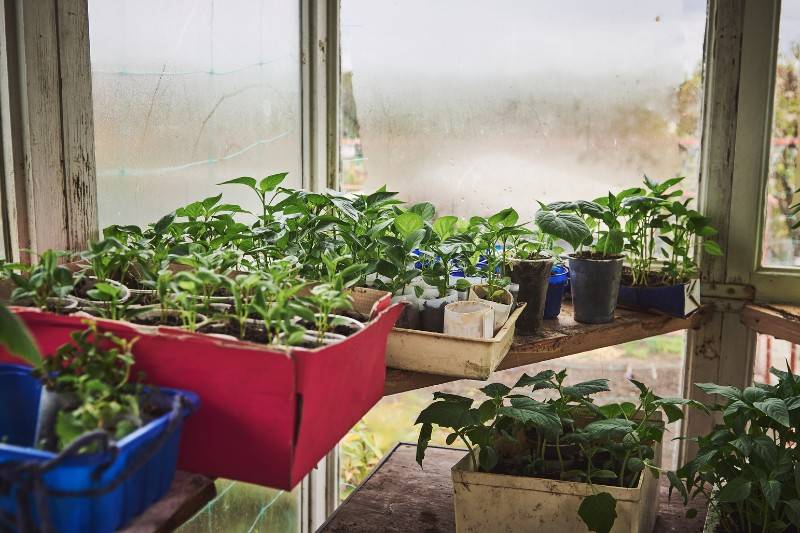

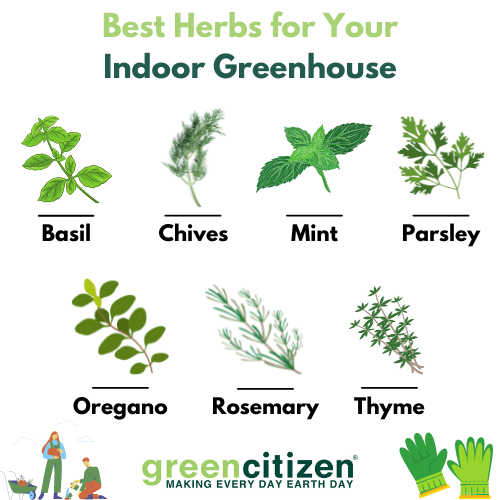
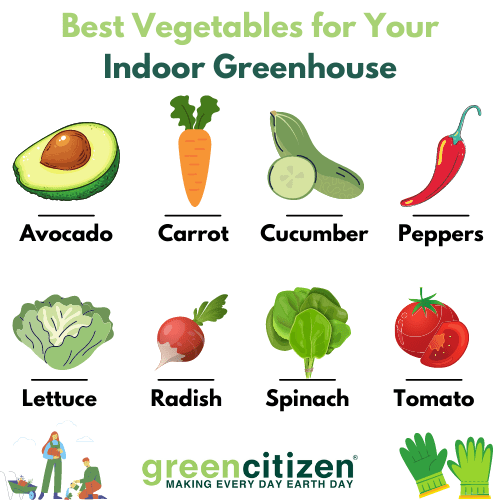
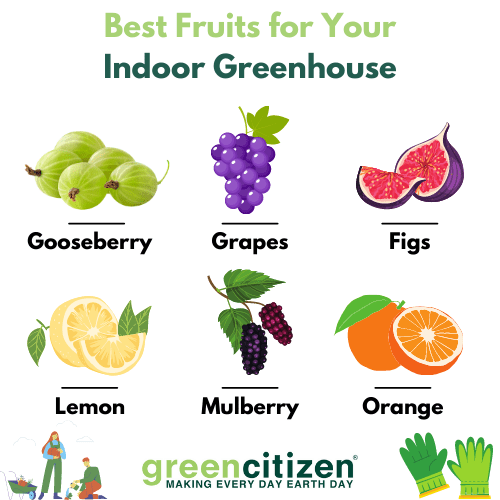









I have a greenhouse on a shelf I made but the bottom isn’t quite sealed. Does the bottom of a greenhouse need to be sealed for it to work properly?
Pingback: Everything you need to know about Microgreen Aquaponics – Japan Aquaponics
I’m so excited to start growing my own vegetables in my indoor greenhouse!
Where can I find the black greenhouse cabinet pictured next to “Why Get an Indoor Greenhouse?”?
Pingback: Spring Gardening 101: What to Plant, What to Harvest, & Planning Your Garden - Urban Leaf website
Pingback: What Are Indoor Greenhouses and Why You Should Get One – The Spicy Trio